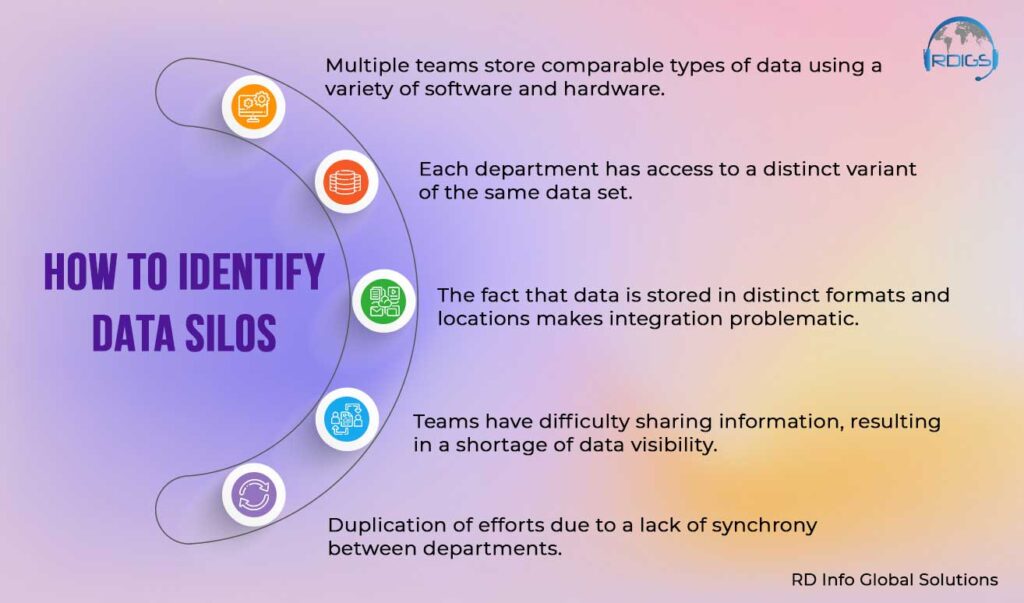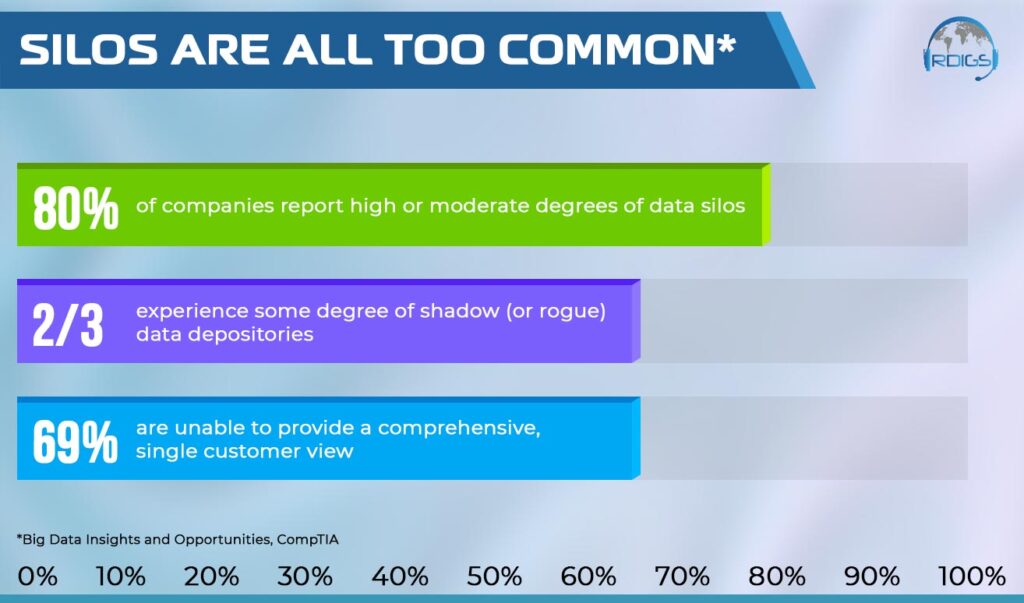Data silos can lead to inaccuracies in insights and decisions. When data is fragmented across different systems or departments, inconsistencies and discrepancies may arise.
Businesses collect vast amounts of data from various sources, ranging from customer information to sales figures and market trends. However, a significant challenge that arises within many B2B organizations is the presence of data silos. These isolated pockets of information within an organization can impede collaboration and create fragmented landscapes that prevent B2B companies from reaching their full potential. This fragmentation of data poses a hidden barrier to effective B2B decision-making.
In this blog, we will explore the impact of data silos on B2B decision-making and discuss strategies to overcome them.
Data silos have a profound impact on decision-making processes in B2B organizations. They create barriers to collaboration by segregating data within different teams or departments. As a result, decision-makers often lack access to a comprehensive view of the business, preventing them from making informed choices that consider the broader context. When crucial information is confined within isolated silos, it becomes challenging to identify trends, correlations, and insights that could drive strategic decision-making.
Decision-makers may base their judgments on incomplete or outdated information, which can significantly impact the quality and reliability of their choices. Inaccurate insights derived from siloed data can have far-reaching consequences for B2B organizations, leading to suboptimal strategies and missed opportunities for growth. By breaking down these silos and promoting data integration and accessibility, organizations can foster collaboration, ensure data consistency, and empower decision-makers with a comprehensive and accurate understanding of the business landscape
Types of Data Silos:
Data silos can manifest in various forms within B2B organizations. They may stem from departmental divisions, where teams hoard data to protect their interests or maintain control over resources. Legacy systems can also contribute to data silos, as outdated technology often lacks interoperability. Additionally, technological limitations or incompatible formats across systems can create silos, making it difficult to integrate data effectively. Here are some common types of data silos found in B2B organizations:
- Departmental Silos
Departmental divisions often lead to the creation of data silos. Different teams or departments within an organization may have their own systems, databases, or tools to collect and store data specific to their functions. Sales, marketing, finance, and customer service departments, for example, may maintain separate repositories of data, resulting in fragmented information landscapes. Silos between departments hinder collaboration and prevent a holistic view of the organization’s data.
- Legacy System Silos
Legacy systems refer to outdated or legacy technology that organizations continue to use due to various reasons such as cost constraints or historical investments. These systems are often incompatible with newer technologies and lack the ability to seamlessly integrate with other systems. As a result, data remains locked within these legacy systems, creating silos that are difficult to bridge. Migrating data from these systems or integrating them with modern systems becomes a complex and time-consuming process.
- Technological Silos
Technological limitations can give rise to silos within B2B organizations. Different software applications, databases, or platforms may store and manage data in different formats or structures, making it challenging to consolidate information. Incompatibility between technologies restricts the flow and integration of data, leading to silos. Additionally, organizations may adopt specialized tools for specific tasks or functions, which further fragment data and create barriers to data integration and accessibility.


- Geographic or Regional Silos
In multinational or geographically dispersed B2B organizations, data silos can emerge based on geographic or regional divisions. Each region or location may maintain its own databases or systems, resulting in data silos that hinder collaboration and decision-making at a global or organizational level. Regional silos can lead to inconsistencies, duplicated efforts, and a lack of centralized data management.
- Vendor or Partner Silos
Collaborating with external vendors, partners, or suppliers often involves sharing and managing data. However, data silos can emerge when each party maintains separate systems or databases. Disconnected data repositories between organizations hinder the seamless exchange and integration of data, making it difficult to obtain a complete and unified view of shared information.
Data Silos Impact on Decision-Making
Data silos have a significant impact on decision-making processes within B2B organizations. They create fragmented information landscapes where data is isolated and confined within different departments, systems, or geographic regions. This fragmentation leads to several negative consequences that hinder effective decision-making. Here are some of the key impacts of data silos:
- Delayed Decision-Making
Data silos often result in delays in decision-making processes. Decision-makers must navigate through various silos and sources to gather the necessary information, which can be time-consuming. Each silo may have its own data collection and analysis processes, causing duplication of efforts and elongating the decision-making timeline. As a result, timely decision-making becomes a challenge, and organizations may miss out on valuable opportunities in fast-paced business environments.
- Redundant Efforts
Data silos contribute to redundant efforts within B2B organizations. When data is isolated within different departments or systems, each team may independently collect and analyze similar data sets. This duplication of efforts wastes valuable time and resources. Instead of leveraging a centralized and integrated data repository, teams may spend significant effort and resources on recreating or revalidating data that already exists elsewhere within the organization. Reducing redundant efforts is crucial for maximizing efficiency and optimizing resource allocation.


- Inaccuracies in Insights
Data silos can lead to inaccuracies in insights and decision-making. When data is fragmented across different sources, there is a higher risk of inconsistencies and discrepancies. Decision-makers may base their judgments on incomplete, outdated, or conflicting data, resulting in flawed insights. Inaccurate insights can lead to suboptimal strategies, missed opportunities, and costly errors. To make informed decisions, decision-makers need access to accurate, comprehensive, and up-to-date data from across the organization.
- Lack of Context and Comprehensive View
Data silos prevent decision-makers from obtaining a holistic and comprehensive view of the business. Each silo contains specific subsets of data, limiting decision-makers ability to understand the broader context and make well-informed choices. Decision-makers require a complete understanding of various aspects of the organization, including sales, marketing, finance, and customer service, to make strategic decisions. Data silos obstruct the integration of information, resulting in a fragmented view that hampers the ability to grasp the interdependencies and relationships within the organization.
- Impeded Collaboration
Collaboration between teams and departments is vital for effective decision-making. However, data silos hinder collaboration by isolating data within specific departments or systems. The lack of a unified data repository makes it challenging for stakeholders to share and access information seamlessly. Silos can create a culture of secrecy or territoriality, inhibiting the free flow of information across the organization. Collaboration suffers, leading to a siloed mindset that limits innovation, knowledge sharing, and collective problem-solving.
Barriers to Data Integration
Integrating data from disparate sources face several barriers. First and foremost, ensuring data quality becomes a challenge when dealing with multiple data silos. Inconsistencies, duplications, and outdated information can undermine the accuracy of insights. Compatibility issues between different systems and formats can further complicate data integration efforts. Organizations must also address concerns related to data security and privacy when sharing data across departments or with external stakeholders. According to the 2022 report by Airtable and Forrester, 80% of business executives consider “reducing data silos” to be their organization’s top priority.


Data Quality
Data quality issues, such as incomplete, inaccurate, or inconsistent data, pose a significant challenge to data integration. When integrating data from multiple sources, ensuring data quality and reliability becomes crucial. Organizations need to establish data quality standards, perform data cleansing and validation processes, and implement data governance practices to address data quality issues.
Compatibility
Different systems and technologies may use varied data formats, structures, or protocols, making it difficult to integrate data seamlessly. Compatibility issues arise when attempting to integrate data from legacy systems, third-party applications, or systems with different technological architectures. Organizations need to invest in technologies or tools that enable data compatibilities, such as data transformation solutions or middleware, to bridge the gap between disparate data sources.
Security and Privacy Concerns
Integrating data from different sources requires careful consideration of security and privacy concerns. Organizations need to ensure that data integration processes comply with relevant data protection regulations and industry standards. Additionally, protecting sensitive or confidential information during data integration is crucial to maintain data security. Implementing robust data access controls, encryption mechanisms, and anonymization techniques can help address security and privacy concerns.
Strategies for Breaking Down Data Silos
To overcome data silos, organizations can implement several practical strategies. First, establishing cross-functional teams that collaborate on data initiatives can bridge the gap between departments and encourage knowledge sharing. Implementing data governance practices ensures consistent data standards, quality, and accountability across the organization. Leveraging technology solutions like data integration platforms simplifies the process of aggregating and harmonizing data from various sources.


- Establish Cross-Functional Teams
Create cross-functional teams that bring together representatives from different departments. These teams can collaborate to identify data integration needs, define data-sharing protocols, and work towards a unified data strategy. Cross-functional collaboration fosters a shared understanding of data requirements and breaks down departmental silos.
- Implement Data Governance Practices
Data governance ensures that data is managed effectively across the organization. Establish data governance frameworks, policies, and guidelines to promote data integration. This includes defining data standards, ensuring data quality, establishing data ownership, and implementing data stewardship roles. Data governance practices provide a structured approach to managing data integration efforts.
- Leverage Technology Solutions
Technology solutions, such as data integration platforms or enterprise integration tools, can streamline data integration processes. These tools facilitate seamless data movement, transformation, and synchronization across systems and sources. Organizations can leverage these technologies to automate data integration tasks, improve data accuracy, and reduce manual efforts.
Real-world example
This real-world example can serve as inspiration for other B2B organizations that a looking to address data silos and unlock the full potential of their data assets. By adopting similar strategies and best practices, organizations can overcome data silos, promote data integration and accessibility, and drive more effective decision-making processes.
Netflix
Netflix, the renowned streaming service provider, tackled data silos to enhance its content recommendation system. Previously, data was siloed within different teams, leading to limited collaboration and fragmented insights. To address this, Netflix implemented a unified data platform called “Data Mesh.” This platform enabled data accessibility and empowered cross-functional teams to access and analyze data directly. As a result, Netflix achieved more accurate content recommendations, leading to increased customer satisfaction and engagement.
These examples highlight successful initiatives undertaken by organizations to tackle data silos and improve decision-making capabilities. The strategies employed by these companies include implementing centralized data platforms, breaking down departmental silos through cross-functional collaboration, and leveraging technology solutions. The outcomes of these initiatives include improved collaboration, faster decision-making, more accurate insights, enhanced operational efficiency, and better customer experiences.
Editor’s Note:
Data silos pose a hidden barrier to effective B2B decision-making. Overcoming this challenge requires organizations to recognize the significance of data accessibility and implement strategies to break down silos. By establishing cross-functional teams, implementing data governance practices, and leveraging technology solutions, businesses can unlock the benefits of integrated data. As the future unfolds, embracing emerging trends and technologies will further empower organizations to dismantle data silos and make more informed decisions. It is time for B2B companies to take action and harness the power of integrated data to drive success in a competitive landscape.
If You Enjoyed Exploring Data Silos: The Hidden Barrier to Effective B2B Decision-Making You’ll Love Our Previous Blog on B2B Customer Journey Orchestration & Touch Points Check it out for more insightful content and expand your knowledge in the world of B2B strategies and customer experiences. Dive in now and discover new perspectives that will take your business to the next level!

